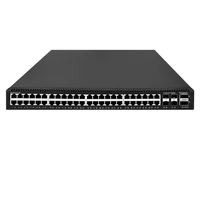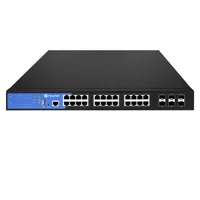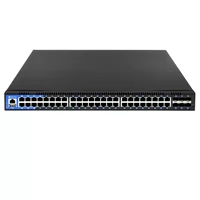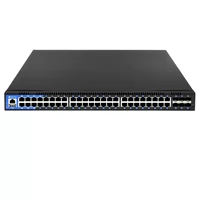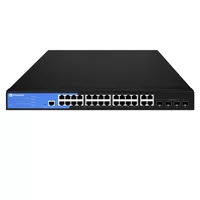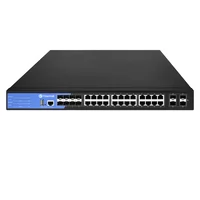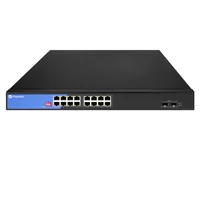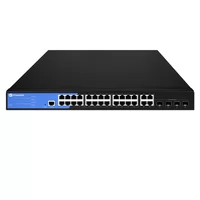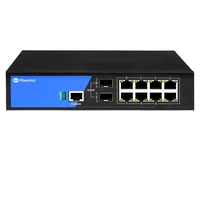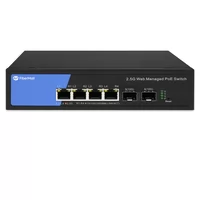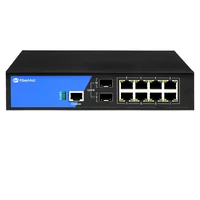Modern networks are becoming increasingly complex and selecting suitable networking equipment has become crucial. One of the most foundational decisions network engineers have to make is whether to implement Layer 2 or Layer 3 switches. Each switch type has its advantages, technical capabilities, and applications tailored for particular network environments. The guide you are reading separates these distinctions so you’re able to make informed choices for your networking requirements. This article aims to bring clarity surrounding the issue of which type of switch is most appropriate for varying configurations. Understanding the differences between Layer 2 and Layer 3 switches is critical for optimizing a small business network or an extensive enterprise infrastructure. These differences ensure the efficiency, scalability, and performance of the network.
Table of Contents
ToggleWhat is a Layer 2 Switch and How Does it Work?
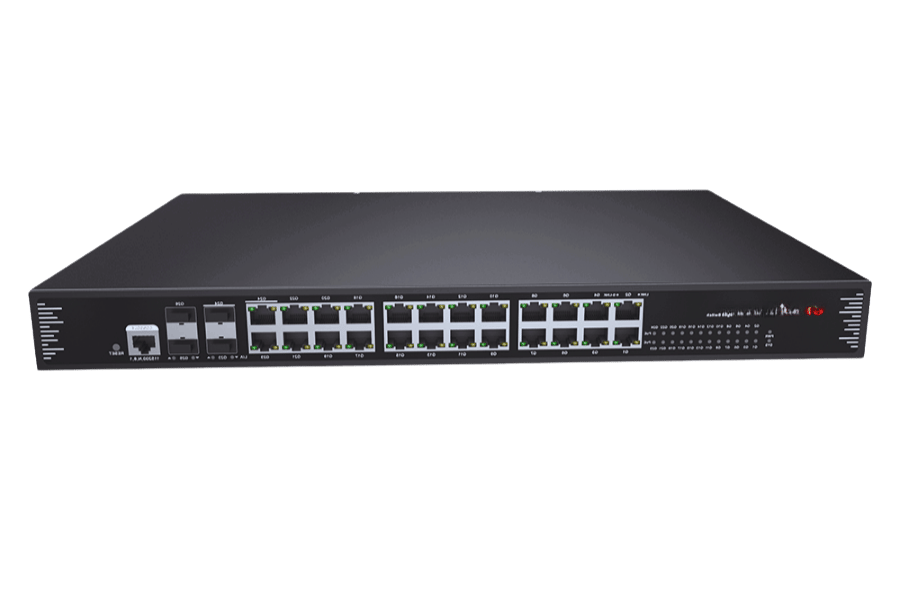
A Layer 2 switch functions at the data link level of the OSI model and is tasked with the forwarding of data within a local area network (LAN). Layer 2 switches use MAC (Media Access Control) addresses to identify the destination of data packets and ensure they are forwarded to the correct device. Layer 2 switches construct a MAC address and port association table which allows them to control traffic without being obliged to disseminate information to every device that is connected. Such a method lowers the load on the network and enhances its overall performance. Layer 2 switches are ideal for supporting communication between devices located within the same network segment, thus becoming the basic building blocks for Local Area Networks.
How a Layer 2 Switch Operates in a Network
A Layer 2 switch functions by using the MAC address of devices to route data within a local area network. It maintains track of incoming frames, saves the source MAC address from incoming frames to its MAC address table, and associates this source MAC address with the appropriate port. When forwarding the data, the switch checks the appropriate port for the destination MAC address, enabling the switch to send the data directly to the recipient of the data without unnecessary traffic. This process reduces unwanted data flow and guarantees effective communication between two or more devices within one local area network segment.
The Role of MAC Address in a Layer 2 Switch
The part of the Layer 2 switch that functions as a network interface controller (NIC) during the switching of data frames and network communication is MAC addresses, which are deeply tied to the MAC address, mingling deep forward to the data link layer of the OSI diagram. Every MAC address serves as an ID to a networking device and per interface card. Within the Layer 2 Switch, the MAC address laid the foundation on which the MAC address table was formed. This table acts as a dynamic search engine through which multiple MAC addresses can be obtained. A switch gets a data frame, the table when a switch gets a datagram and it is expected to use these tables to trace MAC addresses to ports for optimized routing within the local area class network. ___________ Modern MAC address Layer 2 switches can support thousands of MAC addresses which increases flexibility and scalability. For instance, some enterprise-grade switches featuring dense deployment of devices extend more than 3200 MAC addresses or so. Furthermore, switches may implement or make provision for Aging time during which MAC addresses on the table not used for some duration are cleared and hence override the chances of memory overflow and the died efficiency problem.
VLAN (Virtual Local Area Network) segmentation is another activity that is associated with MAC addresses. MAC-based filtering and VLAN tagging make it possible for Layer 2 switches to control the flow of traffic in virtualized network segments, leading to an improvement in security and performance. These functions show how MAC address features extend beyond the mere forwarding of data, rather they actively participate in the management of traffic and communication in a highly intricate network system.
Layer 2 switches employ MAC addressing technology to bolster network access, curtail the volume of broadcasting, and streamline information flow, hence, giving the switches a vital role to play in contemporary networking systems.
Advantages and Limitations of Layer 2 Switches
Benefits of Layer-2 Switches
Enhanced Network Efficiency
Layer 2 switches utilize hardware-level switching through MAC address schemes employing time-efficient techniques to forward data packets unlike routing techniques that depend on software. This will lower the delay of the network, and its performance enhances towards the local environments which are fine-tuned.
Minimized Network Traffic
Layer 2 switches create several collision domains, enforcing efficient network segmentation that help communication with devices in the same broadcast domain to exchange traffic more freely thereby reducing congestion.
Value for Money
Layer 2 switches as compared to Layer 3 switches or routers are cheaper. This makes them suitable for small to medium enterprises that are seeking effective and economical networking devices.
Reduced Complexity of Installation and Configuration
Normally, only basic configurations are needed for Layer 2 switches to work, making it easier for network managers to install devices compared to other higher-layer ones.
VLAN Support Capabilities
Support for Virtual Local Area Networks (VLANs) is common amongst Layer 2 switches. This helps in segmenting the network and facilitates better management of logical groupings in one physical network infrastructure, which makes them easier to maintain.
Increased Scalability for LANs
Layer 2 switches allow IT departments to increment their local area networks with no major reconfiguration allowing organizations to synchronize with the business growth.
Challenges of Layer 2 Switches
Restricted Support for Inter-VLAN Communication
Layer 2 switches are confined to data link activities and cannot complete inter-VLAN routing, so a router or Layer 3 switch is needed for VLAN communication.
Increased Broadcast Traffic
Within their broadcast domain, Layer 2 switches transfer bidirectional traffic. This activity consumes bandwidth and diminishes performance in larger networks with many devices, which leads to more overhead.
Using switches as points of interconnection in a network poses a significant security concern due to weaknesses such as vulnerability to external attacks if the layer 2 MAC address is not protected.
Layer 2 switches remain in a single broadcast domain, which makes them prone to external attacks such as ARP spoofing and MAC flooding, thereby compromising network integrity and security.
Absence of Sophisticated Routing Options
Layer 3 devices, unlike Layer 2 switches, are capable of dynamic routing protocols (like OSPF and BGP) which are essential for complex topologies of networks. Therefore, advance rerouting options are not managed by a Layer 2 switch.
Not Applicable for Wide Area Networks
For facilitation of small to medium networks, operating on layer 2 is a useful option. However, because of the limitations in inter-network communication or routing, advanced devices are mandatory for large scale networks, hence making these switches unsuitable.
Considering these pros and cons enables network designers to strategically place Layer 2 switches in their infrastructure while meeting performance, scalability, and security needs.
How Does a Layer 3 Switch Differ from a Layer 2 Switch?
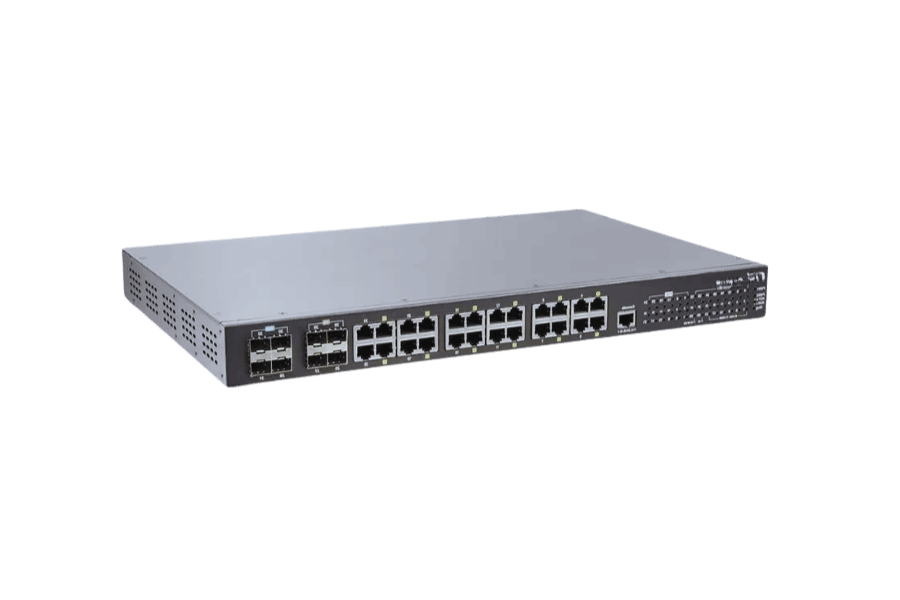
Understanding Layer 3 Routing Capabilities
The defining distinction between a Layer 3 switch and a Layer 2 switch is the Layer 3 switch’s ability to perform routing functions. Layer 2 switches work solely within one network by forwarding data to relevant MAC addresses from the appropriate domain, whereas Layer 3 switches can route traffic between different networks using IP Addresses. The ability to perform routing allows for increased decision-making, particularly in network segmentation and efficiency. A Layer 3 switch is a device that performs both the switching function of a Layer 2 device and the routing function of an ordinary router, thus making a Layer 3 switch more versatile than a standard router. These characteristics allow the Layer 3 switch to excel in enterprise environments that require heavy intra and inter-network communications.
Comparing Layer 2 vs Layer 3 in Network Performance
In relation to networking performance in Layer 2 and Layer 3, it is paramount to understand their specific functions and applications. For instance, standard switches which are Layer 2 devices reside within the Data Link Layer and operate by forwarding frames using MAC addresses within a local area network or a VLAN. These devices are characteristically fast and have little latency because they are involved with intra-network activities like telecommunications within a subnet which improves processing of the destination address. Nonetheless, Layer 2 has a considerable shortcoming in the management of traffic in different networks or subnets as it has no routing facilities.
However, Layer 3 devices which include routers and Layer 3 switches operate at the Network Layer and employ an IP addressing scheme with packet forwarding. Layer 3 switches are faster and more efficient because they integrate the hardware speed of Layer 2 switching with IP routing, making them able to provide inter-network communication. This allows for the creation of network segments, implementation of dynamic routing, prioritizing traffic, and greater overall performance for enterprises with advanced multi-subnet environments that need to be handled.
In terms of broadcast storms or sub-optimal traffic management in large-scale rollouts, Layer 2 networks may perform poorly. On the other hand, the use of Subnetting provides a logical segmentation that aids in isolating traffic for Layer 3 devices. It has been shown that the implementation of Layer 3 switches reduces network congestion in large-scale environments by up to 30% because of improved packet delivery and traffic management.
While latency and throughput are both crucial performance indicators, they also differ based on level. Overall Layer 2 solutions are more efficient in the singular broadcast domain with micosecond level latency. However, as the network expands and requires routing, Layer 3 devices can interconnect subnets with far greater efficiency than their counterparts. They do so with minimal added latency. The amount of added latency is often measured in milliseconds and is speculated based on hardware specification and forwarding rate.
The reliability of Layer 3 and Layer 2 devices is dependent on the specific requirements of the network. For basic local communication, Layer 2 solutions are practical and faster to implement. For more complex, larger, interconnects, or more dynamic networks Layer 3 allows for greater scalability and control along with improved performance.
When to Use a Layer 3 Switch in Your Network
Where high-speed data transfer and advanced network-level routing are required, a Layer 3 switch will be most effective. This type of switching device provides the functions of both Layer 2 (data link layer) and Layer 3 (network layer) devices. Hence, making it possible for complex networks to be managed with low latency. They are best fitted for enterprise level networks, high traffic data centers, and situations that need seamless transfer of information between VLANs (Virtual Local Area Networks).
Large businesses or campuses using different sub-networks can greatly benefit from Layer 3 switches as it allows traffic control at the hardware level through inter VLAN routing which resolves bottlenecks typically caused due to excessive data flow. In addition, removing the dedicated routers enhances performance overall. Reports have shown that Layer 3 switching can achieve throughputs of 1 to 100 Gbps depending on device capabilities, which is ideal for bandwidth intensive applications like VoIP and video streaming as well as large data transfers.
Equally important, Layer 3 switches typically have additional capabilities such as Quality of Service (QoS), Access Control Lists (ACLs), and traffic shaping, which secure, prioritize, and control data flows through the network with precision. Such measures are essential for businesses with more demanding and stringent network reliability requirements, such as financial organizations or specialized healthcare facilities dealing with highly sensitive, life-critical data.
Cost versus value is a notable consideration due to modern Layer 3 switches having scalable implementation options within reasonably priced packages that include enhanced functionalities. Although there is a larger upfront cost compared to a typical Layer 2 switch, the operational efficiency, lower latency, and reduced hardware scope often offset the expense over time.
In conclusion, areas requiring dense and flexible networks complemented with high speed data processing and routing should integrate a Layer 3 switch into their infrastructure. Network performance, security, and manageability provided by these switches surely outline the core element in modern networking architectures.
How to Configure a Layer 2 Switch for Optimal Performance
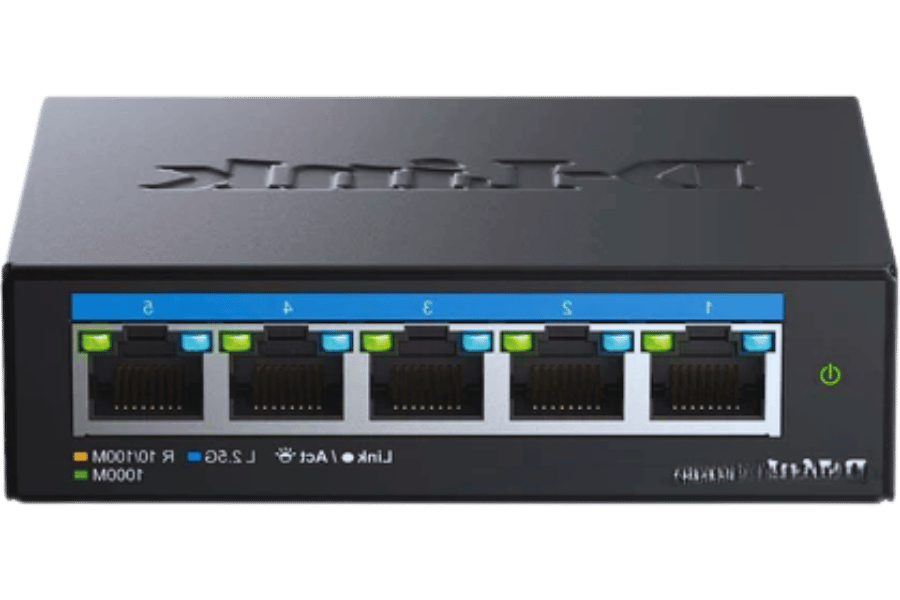
Essential Steps to Configure Layer 2 Settings
Initial Switch Setup
To start, connect to the switch via its management IP. This can be through console access or SSH depending on the make of the device. As discussed, it is important to properly set the static IP address and subnet mask of the switch management interface. For remote management, it is advisable to set the management VLAN to VLAN 1 192.168.1.2/24.
Create and Assign VLANs
VLANs are used for segmentation and traffic separation purposes on layer 2. Login into the command-line interface (CLI), create the VLANs as required, and assign ports to them. For hypothetical use cases, you can create VLAN 10 ‘Accounting’ for ports 1-10, while VLAN 20 ‘Sales’ will take ports 11-20. Such segmentation enhances security and improves the optimization of traffic.
Enable Spanning Tree Protocol (STP)
Enabling STP eliminates loops in the network. Keeping in consideration the range of switches, most of them come with RIspr-SPanning Tree Protocol (RSTP) enabled out of the box. Make sure to verify its status and set the desired priority for the root bridge. About important switches, it is wise to set lower priority values for root bridge selection. This will help to reduce downtime while ensuring redundancy.
Configure Port Security
Apply port security to control network access and improve network discipline. Set the limit for the maximum number of MAC addresses per port and define permitted addresses. For instance, configure port 5 to only allow one particular MAC address, thus restricting access for potentially invasive devices.
Modify Quality of Service (QoS) Parameters
Activate and set up QoS to place higher priority on critical network traffic such as voice and video, compared to regular data packets. Use differentiated services code point (DSCP) values to assign real-time protocols higher priority. This guarantees that operations for quagmire-sensitive projects are dependable.
Confirm And Retain Setup
Confirm all configurations by issuing the commands show vlan, show spanning-tree, and show running-config and validate with accuracy. If everything is set accurately, one will then have to save the changes, to ensure that all configurations are retained after shutting down the device, which is normally done with the command write memory or copy running-config startup-config.
The goal is to streamline the process of managing a Layer 2 switch, boosting its performance, and improving Switch-based Network reliability, scalability segmentation, and security poised for additional future demands. Integrating configuration revisions and performance evaluation into day-to-day management operations should become standard practice.
Utilizing VLAN and Port Management Features
VLANs (Virtual Local Area Networks) and features related to the management of ports are some of the tools for improvement of network optimization, efficiency and security. Network administrators can logically segment traffic to reduce broadcast traffic with VLANs. Sensitive and critical data can now be isolated which decreases the risk of a potential breach while improving overall performance. Port management enhances control through which specific actions are taken on each switch port. Port security settings, speed, and duplex mode are just some of the parameters that can be adjusted to achieve better connectivity. All these features, combined, allow optimization in the management of resources, and flexibility and promote scalability in advanced infrastructures of networks.
Security Features and Access Control in a Layer 2 Managed Switch
VLANs (Virtual Local Area Networks) and port management techniques are some of the methods that can be used to improve the optimization, efficiency, and security of a network. With VLANs, network managers can logically segment traffic to prune broadcast domains. Now sensitive data can be isolated which diminishes the chances of a potential breach while elevating performance. Enhancements of control through specific actions taken on each switch port are referred to as port management. Better connectivity can be attained by adjusting parameters such as port security settings, speed, and duplex mode. Together these features permit optimization in the utilization of resources, flexibility, and advanced infrastructures of network scale up.
Choosing the Right Switch for Your Network: Layer 2 and Layer 3
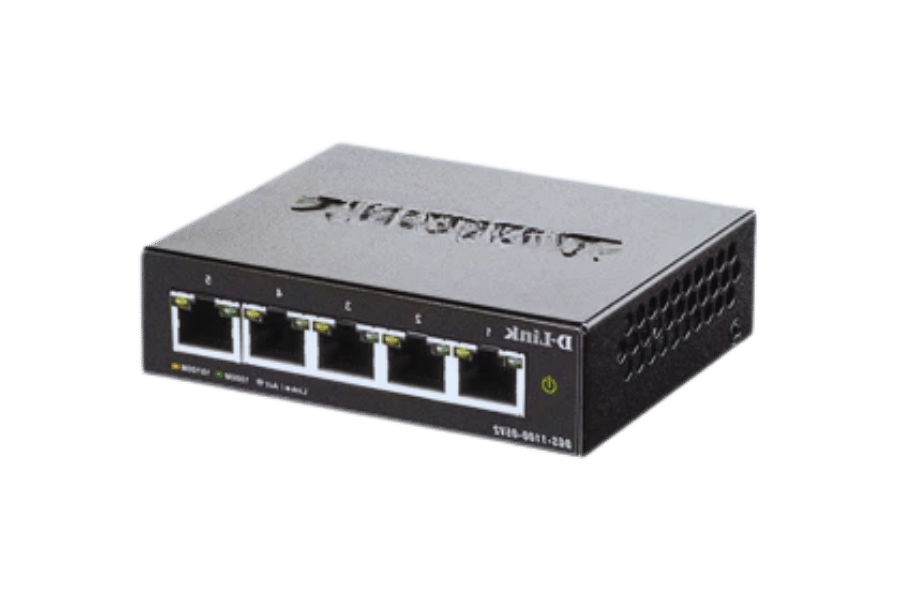
Factors to Consider When Selecting a Switch for Your Network
While choosing a network switch, I pay attention to its performance capabilities and efficiency about expansion planning. To begin with, I consider the scope and scale of the network to identify whether a Layer 2 or a Layer 3 switch would be more appropriate for my purposes. After that, I make sure the switch has the required number of ports for current devices and some for future additions. Moreover, I determine whether the switch’s throughput and bandwidth capabilities will satisfy projected network traffic growth. Other important considerations include PoE features, security policies, and management features, which must be in sync with the overall strategy for network resources. One of the last points is planning about controllable expenses; in this case, I make sure the selected switch does not incur unnecessary costs.
Benefits of Managed Switch vs Unmanaged Switches
Managed switches offer improved control, flexibility, and scalability when put side by side with unmanaged switches. They provide configurational and monitoring capabilities over network settings, aside from implementing security and traffic prioritization policies, making them suitable for intricate or expanding networks. Conversely, unmanaged switches are more straightforward and economical, making them fit for small-scale static networks that do not require advanced features. They also lack basic managed switch capabilities, such as performance optimization and enhanced reliability gained from traffic management and detailed diagnostics. Unmanaged switches are, however, appealing to basic users due to the minimal setup and maintenance requirements.
The Role of Port Gigabit Switch in Network Efficiency
Port Gigabit switches are pivotal in improving the performance of a network by ensuring rapid data transfer, lowering latency, and enhancing the performance of the network as a whole. As such, these switches allow multiple devices to interact at gigabit speeds, thus accommodating data-demanding operations such as video streaming, cloud computing, and other large file transfers. Furthermore, these switches are also well suited for evolving network infrastructure for modern enterprises as well as home users оптимизированные for dependable and high-speed access.
Exploring the Difference Between Layer 2 and Layer 3 Switches in Networking
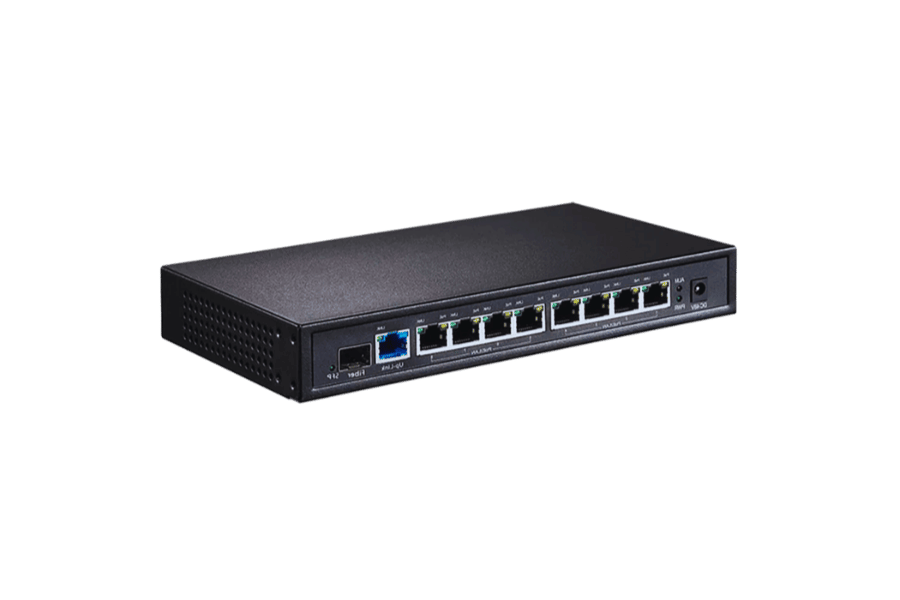
How Switching and Routing Impact Network Traffic
Both switching and routing perform different functions with varying complexity and interrelate with one another in the management of network traffic. As pertaining to switching, this operates at layer two (2) of the OSI model—the switching also known as MAC bridges concentrates on the movement of data packets within a local area network and uses MAC addresses for ‘addressing’. This level of operation ensures that, within a certain segment of the network, devices are able to communicate with each other and initial collisions caused by data exchange are minimized.
Routing, on the contrary, operates at layer three (3) and is in charge of the movement of data from a particular network to another network with the aid of an IP address. In other words, routing enables intercommunication and information exchange between devices in large networks e.g. globular connection of a local area network to the internet. All these things can be accomplished because there is a specification of optimal routes and networks for data and information.
In essence, both switching and routing work together since switching takes care of internal efficiency of a network as routing integrates different networks. Thus, both functions represent differing but complementary requirements within networking.
The Importance of MAC Address Table in Layer 2 Operations
A MAC address table is significant in the operations of Layer 2 of networking. This table is kept by Ethernet switches, which map the MAC addresses of the connected devices to specific switch ports, so that packets of data can be sent to the correct device within a local area network (LAN). In simpler terms, when a switch receives a frame, the MAC address table is checked first to decide which port to send it to. This way, frames are not sent to every port, which in turn makes the network better and less crowded.
Most enterprise-grade switches today come equipped with the capability of keeping hundreds or thousands of MAC addresses in their tables. An example is modern ones that come with hardware tables that can have over 32,000 MAC addresses. This makes sure that they can be scaled up and network functions properly. The ability to update the MAC address table with the addresses of the devices connected to the network is called dynamic learning and it is a feature that is available in many of the modern switches. By employing this, the switches will be able to keep track of devices connected to the network without needing to reconfigure the device to send data to all ports.
In the absence of proper management of the MAC address table, excessive broadcast traffic may hinder network performance due to increased collision domains. This is especially true in real-time applications like VoIP and video streaming. Poor frame forwarding mechanisms can introduce unacceptable delays which may degrade the overall user experience. Hence, the proper use of MAC address tables is critical for maintaining system balance, minimizing latency, and improving operational efficiency at Layer 2 in contemporary networks.
Understanding Switching Frames and Data Flow
As with any computer network, or group of switching frames, automatic action is performed regarding the receiving, manipulating, and sending of data packets in more of a physical sense through a switch device on layer two of the OSI model. The layer serves as a middle ground, dividing the system into two parts: the upper layer which is less hardware-dependent, and the lower part which is more hardware-reliant. About layer 2, the frame contains a header that has information about the physical unit of the frame coming to, or leaving the layer. Another key point to remember is that every switch contains a MAC address table. This table decides whether to allow access to an address space or block access based on the forwarding decisions.
The beginning of the process is in the reception of the frame at the switch port. Every frame is tagged with a MAC address, and a switch is associated as an intuitive device because it can consult the MAC address and give it a slot. If one of the slots has a port that does not have an address available, the switch does an action that needs other ports, sending the frame through every interface except the one that it is arriving from, hoping that at least one of the ports that added it has a destination MAC. The operation completes the initial stage of the learning phase where addresses can be added to the MAC table.
Improvements in technology have greatly increased switching capabilities. For example, modern switches feature ASIC (Application-Specific Integrated Circuit) based hardware switches that are capable of frame processing at the rate of millions per second. These devices enable the achievement of multi-digit microsecond response times, and uninterrupted data streaming in areas where communication latency must be extremely minimal, for instance in financial transactions or HD content streaming. Moreover, tools for monitoring network performance indicate that switches equipped with advanced packet buffering features are capable of burst traffic management which results in less frame drops during peak usage.
For modern high-bandwidth applications, VLAN segmentation and Quality of Service (QoS) related traffic prioritization techniques are indispensable. VLANs, on one hand, assist in organizing and isolating the incoming traffic helping reduce the problem of unsolicited data interference; while on the other, QoS allows for the prioritization of critical streams like VoIP over the relatively less urgent data streams. All of these factors contribute to improving the design and robustness of modern network architectures in terms of performance, scalability, and reliability.
Frequently Asked Questions (FAQs)
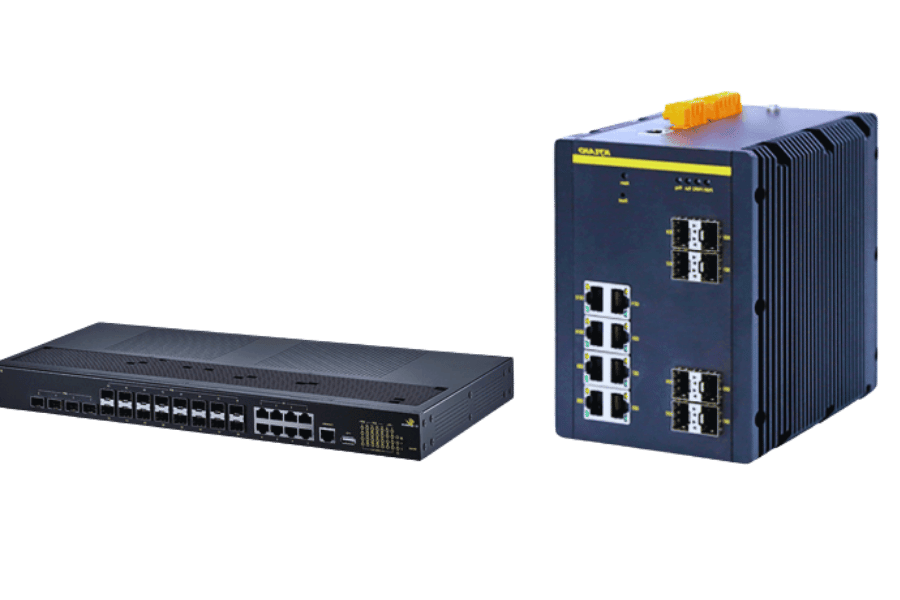
Q: What is the major difference between a router and a layer 3 switch?
A: Layer 3 routers and switches differ optimally in functionality, design, and application. A router’s primary function is to interconnect different networks and perform routing actions in contrast to that of a switch, which is designed as a router-enhanced high-speed switch. Additionally, routers tend to contain advanced routing protocols alongside WAN capabilities while layer 3 switches comprise the FSW of a layer 2 switch with some IP routing capabilities. Both devices utilize routing tables and make forwarding decisions based on IP addresses, however, layer 3 switches are known to be better in packet processing in LAN environments due to hardware-based routing rather than software.
Q: What is the difference between a Cisco layer 3 and a layer 2 ethernet switch?
A: A Cisco ethernet layer 2 switch focuses exclusively on data link layer functions. A Layer 2 Switch can forward a frame within a switch based on the MAC address within the frame. A layer 2 switch creates segments on the network and is capable of managing VLANs within a broadcast domain. As compared to these, Cisco layer 3 switches are capable of performing all functions of a layer 2 switch, plus perform the additional functions of a router. This allows them to make forwarding decisions based on IP addresses, route between VLANs, and utilize routing protocols such as OSPF and EIGRP. Cisco layer 3 models are more commonly used in enterprise core and distribution layers because they tend to have better QoS performance, security features, and port density.
Q: What is the difference in functionality between layers 2 and 3 for ethernet switches?
A: An ethernet switch looks at the destination MAC address for incoming frames and, relying on its layer two MAC address table, forwards it to the relevant switch port. As layer two devices, switches cannot route between networks or VLANs without the help of an external router. This means that they only function on the data link layer of the Open Systems Interconnection model. Unlike layer two switches, layer three switches examine the destination IP address of the packet, in addition to performing all layer two functions. This enables layer three switches to route between different networks or VLANs, control access lists based on the IP information, and utilize routing protocols. In other words, layer three switches combine the functionality of a switch and a router into a single network device.
Q: Which model of Ethernet switch should I use for my network, Layer 2 or Layer 3?
A: A layer 2 ethernet switch is most useful when there is a basic need to maintain a connection within a single network segment with speed frame forwarding, as well as, simple networking needs and little inter-VLAN communication. A basic switch is adequate for small offices, edge networks, or when there is a separate router performing the switching functions. A layer 3 switch is selected to enable inter-VLAN routing without an extra device, for high-performance routing within a LAN, complex network segmentation, or sophisticated traffic management. Layer 3 switches are preferred at the network core, distribution layer, or campus network for large organizations with high bandwidth requirements and where the traffic from multiple VLANs needs routing.
Q: What is the difference in the management of routing tables by layer 3 switches and traditional routers?
A: Layer 3 switches manage their networks’ routing tables as sophisticated as traditional routers do, which includes keeping track of network destinations and hops. Even though layer 3 switches have routing tables like traditional routers, the switches carry out the routing functionalities using hardware (ASICs), which is, compared to software-based routers, notably faster. They support standard routing protocols like OSPF, EIGRP, and RIP, but could have suppressed more complex routing abilities than primary routers. Furthermore, layer 3 switches perform well in inter-VLAN routing in the local area network (LAN), while they may underperform in the wide area network (WAN) connections and complex routing tasks. Their routing tables are optimized for faster functioning in a local area network rather than a wide area network.
Q: What are the differences in the treatment of data packets between a layer 3 managed switch and a layer 2 switch?
A layer 3 managed switch is capable of processing data packets with greater depth than that of a layer 2 switch since it can analyze the data based on the destination address. Both managed and unmanaged switches examine frame headers, however, layer 2 switches are only limited to looking at MAC addresses that are used as the destination. Unlike layer 2 switches, a managed layer 3 switch can perform routing, which is made possible through the additional capability of looking deeper into the IP header. Because of this, the switch can route traffic between different VLANs or subnets without the assistance of an external router. Managed layer 3 switches support the use of arping which uses address resolution protocols to link an IP address to a MAC address. QoS policies as well as access control can also be given at layer 3 which makes the management of network traffic through layer 3 value both more flexible and complex than with layer 2.
Q: What purpose does a Layer 3 switch have in a network that already has a router?
A: There are several reasons that you may still need a layer 3 switch even with an existing router. First, a layer 3 switch usually has a higher throughput for inter-VLAN routing that is much greater than a traditional router, which eliminates network stagnation. Second, they improve the speed of the network or circuit by performing routing in hardware instead of software. Third, a layer 3 switch improves the overall network design by combining switching and routing into one device and reducing the need for a layer 2 switch when there is a layer 3 switch option. Also, in huge networks with a number of VLANs, offloading intradomain routing to layer 3 switches helps distribute the load to the router and prevents it from being overused. Lastly, layer 3 routers are known for their high switched port output, thus enabling greater connection density and routing at the same time.
Q: In what ways does a layer 3 gigabit ethernet switch aid in faster network operations?
A: The network performance gains from a Layer 3 capable ethernet gigabit switch is multifold. These switches also combine high-speed switching, at gigabit or higher speeds with routing functions, eliminating the archaic delay of having to route traffic through a separate, usually much slower, router. Layer 3 switches use hardware (ASICs) for making the routing decision instead of software. This allows for vastly increased throughput and lower latency for routed traffic. They allow direct routing between VLANs at wire speed, which is beneficial to performance for inter-VLAN communications. In addition, these switches are also able to implement advanced traffic management features such as QoS for critical applications. The switches also have higher port density compared to traditional routers so more devices can be connected at gigabit speeds and benefit from packet switching and routing inside the device.
Q: Which factors are most important to consider for determining whether a layer 2 switch meets the network needs of my organization?
A: If you are trying to establish if a layer 2 switch would be sufficient, it is important to analyze the scope of your network’s complexity, size, and future expansion. A layer 2 switch is likely adequate if, there is only one subnet or a few VLANs within the network; there is little intra-VLAN traffic; there already exists a router that performs routing functions; the inter-network bandwidth utilization is low; and the emphasis is on value as opposed to advanced features. In addition, determine if there are basic QoS and security requirements that are satisfied, considering that layer 2 switches offer limited features when compared to layer 3 switches. If your organization is small and has simple connectivity requirements that do not require network segmentation, then layer 2 switches would suffice. If on the other hand, you expect more users and a more complicated network design, then it would be advisable to invest in a layer 3 switch.
Reference Sources
1. A novel approach to solve the layer 2 loop problem in Software Defined Networks (SDNs)
- Primary Author: Esmaeil Amiri Secondary Author: R. Javidan
- Year of Publication: 2019
- Publication: Telecommunications Systems
- CITATION TOKEN: (Amiri and Javidan, 2019, pp. 47–57)
SYNOPSIS
- In this paper the authors propose a new technique for the loop prevention problem in Layer 2 networks of Software Defined Networking (SDN). Their approach is compared with the Spanning Tree Protocol (STP), claiming that their method provides better results in terms of blocking switch ports and using switch capacity. The methodology includes theories along with simulations to prove the effectiveness of the suggested loop prevention design.
2. A Hybrid SDN Switch Based On Standard P4 Code
- Authors: J. Alvarez-Horcajo et al.
- Publication Year: 2021
- Journal: IEEE Communications Letters
- Citation Token: (J. Alvarez-Horcajo et al, 2021, pp. 1482-1485)
Summary:
- This research proposes a new hybrid Software-Defined Networking (SDN) Layer-2 switch using the Programmable Protocol-independent Packet Processors (P4) language. The switch’s behavior is specified with P4Runtime and hence programmable data plane functions are achievable. The authors claim better performance than other P4 proposals, commenting on the switch’s capability of self-configuring its forwarding features. The methodology consists of performance comparisons with other implementations.
3. P4VBox: Implementing Virtualization in P4 Compatible Switches
- Author(s): Mateus Saquetti et al.
- Year of Publication: 2020
- Source: IEEE Communications Letters
- Citing Information: (Saquetti et al., 2020, pp. 146–149)
Overview:
- In this paper, we present P4VBox, a framework that facilitates the virtualization of P4 switches. The authors validate the possibility of parallel execution of numerous virtual switch instances which leads to greater ease of use and efficiency in network management. The research demonstrates the possibility of executing up to 13 virtual switches at the same time which greatly enhances bandwidth and reduces latency. The approach is based on actual implementation on a NetFPGA-SUME board.
5. Routing
Related Products:
-
 S3100-48T2Q4X, 48-Port Ethernet Switch, 48x 10/100/1000/2500/10G BASE-T RJ45, with 2x 40G SFP+ and 4x 1G/10G SFP+ Uplinks
$1095.00
S3100-48T2Q4X, 48-Port Ethernet Switch, 48x 10/100/1000/2500/10G BASE-T RJ45, with 2x 40G SFP+ and 4x 1G/10G SFP+ Uplinks
$1095.00
-
 S3100-24T6X-P, 24-Port Ethernet Switch L3, PoE+ Switch, 24x 10/100/1000/2500 BASE-T RJ45, with 6x 1G/10G SFP+ Uplinks
$746.00
S3100-24T6X-P, 24-Port Ethernet Switch L3, PoE+ Switch, 24x 10/100/1000/2500 BASE-T RJ45, with 6x 1G/10G SFP+ Uplinks
$746.00
-
 S3100-48T6X-P, 48-Port Ethernet Switch L3, PoE+ Switch, 48x 10/100/1000BASE-T RJ45, with 6x 1G/10G SFP+ Uplinks
$734.00
S3100-48T6X-P, 48-Port Ethernet Switch L3, PoE+ Switch, 48x 10/100/1000BASE-T RJ45, with 6x 1G/10G SFP+ Uplinks
$734.00
-
 S3100-8T4X, 8-Port Ethernet Switch L3, 8x 10/100/1000/2500/10G BASE-T RJ45 Ports, with 4x 1G/10G SFP+ Uplinks
$398.00
S3100-8T4X, 8-Port Ethernet Switch L3, 8x 10/100/1000/2500/10G BASE-T RJ45 Ports, with 4x 1G/10G SFP+ Uplinks
$398.00
-
 S3100-48T6X, 48-Port Ethernet Switch L3, 48x 10/100/1000BASE-T RJ45, with 6x 1G/10G SFP+ Uplinks
$365.00
S3100-48T6X, 48-Port Ethernet Switch L3, 48x 10/100/1000BASE-T RJ45, with 6x 1G/10G SFP+ Uplinks
$365.00
-
 S2100-24T4TS-P, 24-Port Ethernet Switch L2+, PoE+ Switch, 24x 10/100/1000BASE-T RJ45, with 4x 1G RJ45/SFP Combo Uplinks
$360.00
S2100-24T4TS-P, 24-Port Ethernet Switch L2+, PoE+ Switch, 24x 10/100/1000BASE-T RJ45, with 4x 1G RJ45/SFP Combo Uplinks
$360.00
-
 S3100-16T8TS4X, 16-Port Ethernet Switch L3, 16x 10/100/1000BASE-T RJ45, with 8 x 1Gb RJ45/SFP Combo and 4 x 1Gb SFP Uplinks
$340.00
S3100-16T8TS4X, 16-Port Ethernet Switch L3, 16x 10/100/1000BASE-T RJ45, with 8 x 1Gb RJ45/SFP Combo and 4 x 1Gb SFP Uplinks
$340.00
-
 S2100-16T2S-P, 16-Port Ethernet Switch L2+, PoE+ Switch, 16x 10/100/1000BASE-T RJ45, with 2x 1G SFP Uplinks
$230.00
S2100-16T2S-P, 16-Port Ethernet Switch L2+, PoE+ Switch, 16x 10/100/1000BASE-T RJ45, with 2x 1G SFP Uplinks
$230.00
-
 S2100-24T4TS, 24-Port Ethernet Switch L2+, 24x 10/100/1000BASE-T RJ45, with 4x 1G RJ45/SFP Combo Uplinks
$148.00
S2100-24T4TS, 24-Port Ethernet Switch L2+, 24x 10/100/1000BASE-T RJ45, with 4x 1G RJ45/SFP Combo Uplinks
$148.00
-
 S2100-8T2S-P, 8-Port Ethernet Switch L2+, PoE+ Switch, 8x 10/100/1000BASE-T RJ45, with 2x 1G SFP Uplinks
$139.00
S2100-8T2S-P, 8-Port Ethernet Switch L2+, PoE+ Switch, 8x 10/100/1000BASE-T RJ45, with 2x 1G SFP Uplinks
$139.00
-
 S3100-4T2X-P, 4-Port Gigabit Ethernet Managed Switch, PoE+ Switch, 4x 10/100/1000/2500 BASE-T RJ45, with 2x 1G/10G SFP+ Uplinks
$90.00
S3100-4T2X-P, 4-Port Gigabit Ethernet Managed Switch, PoE+ Switch, 4x 10/100/1000/2500 BASE-T RJ45, with 2x 1G/10G SFP+ Uplinks
$90.00
-
 S2100-8T2S, 8-Port Ethernet Switch L2+, 8x 10/100/1000BASE-T RJ45, with 2x 1G SFP Uplinks
$71.00
S2100-8T2S, 8-Port Ethernet Switch L2+, 8x 10/100/1000BASE-T RJ45, with 2x 1G SFP Uplinks
$71.00

